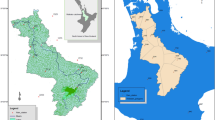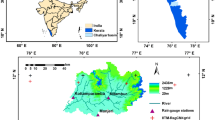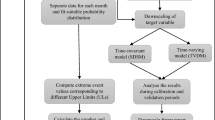Abstract
The temporal variability in yearly and seasonal extreme precipitation across Turkey is investigated using stationary and nonstationary frequency approach. Four frequency distributions namely, generalized extreme value (GEV), gumbel, normal, and lognormal distributions are used for the historical period (1971–2016) as well as the projection period (2051–2100). The nonstationarity impacts are determined by calculating the percentage difference of return levels (30 years) between stationary and nonstationary cases for both periods. The results are presented as nonstationarity impact maps across Turkey, providing information about the spatial variability of the magnitude of impacts as well as the impact types, i.e., the increase or decrease in return levels of extreme precipitation. For nonstationarity analysis during the projection period, the projected precipitation data is obtained from a 12-member ensemble of the Coordinated Regional Downscaling Experiment (CORDEX) regional climate models (RCM) based on the worst emission scenario (RCP8.5). In addition to this, the effects of bias-corrections on stationarities are also investigated for selected RCMs. Performance evaluation of CORDEX ensemble members suggested significant intramodel and intraregion variability in the simulation of historical precipitation. Overall, GEV provided the best fit while normal distribution provided the worst fit to precipitation extremes. However, with a few exceptions, all the distributions exhibited a similar pattern for the historical impacts of nonstationarities across the country. The yearly nonstationarity impacts for the 30-year return level reached 35, 30, 25, and 20% for the Mediterranean, Aegean, Marmara, and Black sea regions, respectively, while a mixed type of nonstationarity impacts was found in Central, Eastern, and South-Eastern Anatolia regions. Moreover, the magnitude and impact type of nonstationarity showed important variations between the seasons. The ensemble analyses of CORDEX-based projected precipitation demonstrated that during the projection period, the nonstationarity impacts are found to be different in magnitude and type as compared to the impacts during the historical period in many regions (particularly in the eastern part of Turkey). The 30-year return levels of extreme precipitations are expected to increase (up to 30%) across Turkey in the yearly, winter, spring, and autumn seasons during the projection period. However, during the same period, the summer extremes in Eastern Anatolia and Mediterranean regions decreased ( up to 30%) with nonstationarity. Projected increases in the precipitation extremes lead to more floods and winter storms, while decreases in the summer precipitations will further dwindle water availability.








Similar content being viewed by others
References
Alpert P, Osetinsky I, Ziv B, Shafir H (2004) Semi-objective classification for daily synoptic systems: application to the eastern Mediterranean climate change. Int J Climatol 24:1001–1011. https://doi.org/10.1002/joc.1036
Aziz R, Yucel I, Yozgatligil C (2020) Nonstationarity impacts on frequency analysis of yearly and seasonal extreme temperature in Turkey. Atmos Res. https://doi.org/10.1016/j.atmosres.2020.104875
Barcikowska MJ, Kapnick SB, Krishnamurty L, Russo S, Cherchi A, Folland CK (2019) Changes in the future summer Mediterranean climate: contribution of teleconnections and local factors. Earth Syst Dyn Discuss:1–43. https://doi.org/10.5194/esd-2018-85
Bayazit M (2015) Nonstationarity of hydrological records and recent trends in trend analysis: a state-of-the-art review. Environ Process 2(3):527–542
Bozkurt D, Sen OL (2013) Climate change impacts in the Euphrates–Tigris Basin based on different model and scenario simulations. J Hydrol 480:149–161. https://doi.org/10.1016/j.jhydrol.2012.12.021
Brown JR, Lengaigne M, Lintner BR, Widlansky MJ, van der Wiel K, Dutheil C, Linsley BK, Matthews AJ, Renwick J (2020) South Pacific Convergence Zone dynamics, variability and impacts in a changing climate. Nat Rev Earth Environ. https://doi.org/10.1038/s43017-020-0078-2
Cannon AJ (2011) GEVcdn: An R package for nonstationary extreme value analysis by generalized extreme value conditional density estimation network. Comput Geosci 37:1532–1533
Cooley D (2013) Return periods and return levels under climate change. In: AghaKouchak A, Easterling D, Hsu K, Schubert S, Sorooshian S (eds) Extremes in a changing climate. Water Science and Technology Library, vol 65. Springer, Dordrecht. https://doi.org/10.1007/978-94-007-4479-0_4
Coles S (2001) An introduction to statistical modeling of extreme values. Springer Series in Statistics. Springer Verlag London
Demir İ, Kılıç G, Coşkun M (2008a) Maximum, minimum and average temperature and precipitation changes and trends observed in the series in Turkey. Union of Chambers of Turkish Engineers and Architects Climate Change Symposium Proceedings, 69-84. Chamber of Meteorological Engineers, 13- 14 March 2008, Ankara
Demir İ, Kılıç G, Coşkun M (2008b) PRECIS regional climate model climate projections for Turkey: HadAMP3 SRES A2 scenarios. IV. Atmospheric Sciences Symposium Proceedings, 365-373. Istanbul Technical University, Faculty of Aeronautics and Astronautics, Department of Meteorology Engineering, 25-28 March 2008, İstanbul
Fischer E, Knutti R (2015) Anthropogenic contribution to global occurrence of heavy-precipitation and high-temperature extremes. Nat Clim Chang 5:560–564. https://doi.org/10.1038/nclimate2617
Gilleland E (2016) extRemes: extreme value analysis. R package version 2.0-8, URL https://CRAN.R-project.org/package=extRemes
Gilleland E, Katz R (2011) New software to analyze how extremes change over time. EOS Trans Am Geophys Union 92(2):13–14
Giorgi F, Lionello P (2008) Climate change projections for the Mediterranean region. Glob Planet Chang 63:90–104. https://doi.org/10.1016/j.gloplacha.2007.09.005
Heffernan J, Stephenson A (2012) ismev: an introduction to statistical modeling of extreme values. R package version 1.39, Original S functions written by Janet E. Heffernan with R port and R documentation provided by Alec G. Stephenson, URL https://CRAN.R-project.org/package=ismev
IPCC (2007a) Climate Change 2007: the physical science basis. Contribution of Working Group I to the Fourth Assessment Report of the Intergovernmental Panel on Climate Change. Cambridge University Press, Cambridge
IPCC (2007b) In: Parry ML, Canziani OF, Palutikof JP, van der Linden PJ, Hanson CE (eds) Climate Change 2007: impacts, adaptation, and vulner-ability. Cambridge University Press, Cambridge
Katz RW (2013) In: AghaKouchak A, Easterling D, Hsu K (eds) “Statistical methods for nonstationary extremes.” Chapter 2, Extremes in a changing climate: Detection, analysis and uncertainty, vol 65. Springer, New York
Kharin V, Zwiers F, Zhang X, Wehner M (2013) Changes in temperature and precipitation extremes in the CMIP5 ensemble. Clim Chang 119. https://doi.org/10.1007/s10584-013-0705-8
Lucas C, Timbal B, Nguyen H (2014) The expanding tropics: a critical assessment of the observational and modeling studies, vol 5. Wiley Interdisciplinary Reviews: Climate Change. https://doi.org/10.1002/wcc.251
Maraun D (2016) Bias correcting climate change simulations—a critical review. Curr Clim Change Rep 2(4):211–220
Milly P, Betancourt J, Falkenmark M, Hirsch RM, Kundzewicz ZW, Lettenmaier DP, Stouffer RJ (2008) Stationarity is dead: whither water management? Science. 319:573–574
O’Gorman PA, Muller CJ (2010) How closely do changes in surface and column water vapor follow Clausius-Clapeyron scaling in climate change simulations? Environ Res Lett 5:025207. https://doi.org/10.1088/1748-9326/5/2/025207
Önol B, Semazzi FHM (2009) Regionalization of climate change simulations over the Eastern Mediterranean J. Clim. 22(8):1944–1961. https://doi.org/10.1175/2008JCLI1807.1
Perkins SE, Alexander LV, Nairn JR (2012) Increasing frequency, intensity and duration of observed global heatwaves and warm spells. Geophys Res Lett 39:L20714
Salas JD, Obeysekera J (2014) Revisiting the concepts of return period and risk for non-stationary hydrologic extreme events. J Hydrol Eng 19:554–568
Sensoy S, Demircan M (2016) Climate of Turkey. http://www.topraksuenerji.com/Climate_of_turkey.pdf
Sensoy S, Türkoğlu N, Akçakaya A, Ekici M, Ulupinar Y, Demircan M, Atay H, Tüvan A, Demirbaş H (2013) Trends in Turkey Climate Indices from 1960 to 2010
Sherwood SC, Roca R, Weckwerth TM, Andronova NG (2010) Tropospheric water vapor, convection, and climate. Rev Geophys 48:RG2001. https://doi.org/10.1029/2009RG000301
Simmons AJ, Willett KM, Jones PD, Thorne PW, Dee DP (2010) Low-frequency variations in surface atmospheric humidity, temperature, and precipitation: Inferences from reanalyses and monthly gridded observational data sets. J Geophys Res 115:D01110
Small D, Islam S, Vogel RM (2006) Trends in precipitation and streamflow in the eastern US. Paradox or perception? Geophys Res Lett 33:L03403. https://doi.org/10.1029/2005GL024995
Sun Y, Solomon S, Dai A, Portmann RW (2007) How Often Will It Rain? J Clim 20:4801–4818. https://doi.org/10.1175/JCLI4263.1
Trenberth KE, Jones PD, Ambenje P, Bojariu R, Easterling D, Klein Tank A, Parker D, Rahimzadeh F, Renwick JA, Rusticucci M, Soden B, Zhai P (2007) In: Solomon S, Qin D, Manning M, Marquis M, Averyt K, Tignor MMB, Miller HL Jr, Chen Z (eds) Observations: surface and atmospheric climate change. InClimate Change 2007: The Physical Science Basis.Contribution of Working Group I to the Fourth Assessment Report of the Intergovernmental Panel on Climate Change. Cambridge University Press, Cambridge, pp 235–336
Tuel A, Eltahir EAB (2020) Why is the Mediterranean a climate change hot spot? J Clim 33:5829–5843. https://doi.org/10.1175/JCLI-D-19-0910.1
Turgay P, Kahya E (2005) Trend analysis in Turkish precipitation data. Hydrol Process 20:2011–2026 (2006) Published online 23 December 2005 in Wiley InterScience (www.interscience.wiley.com). https://doi.org/10.1002/hyp.5993
Türkeş M, Koç T, Sariş F (2009) Spatiotemporal variability of precipitation total series over Turkey. Int J Climatol 29:1056–1074
Türkeș M, Yozgatlıgil C, Batmaz İ, İyigün C, Kartal KE, Fahmi FM, Aslan S (2016) Has the climate been changing in Turkey? Regional climate change signals based on a comparative statistical analysis of two consecutive time periods, 1950-1980 and 1981-2010. Clim Res 70:77–93
Vrac M, Drobinski P, Merlo A, Herrmann M, Lavaysse C, Li L, Somot S (2012) Dynamical and statistical downscaling of the French Mediterranean climate: uncertainty assessment. Nat Hazards Earth Syst Sci 12:2769–2784. https://doi.org/10.5194/nhess-12-2769-2012
Webb JW, White KD (2010) Nonstationarity in water management: USACE perspective. Workshop on nonstationarity, hydrological frequency analysis and water management 2010, Colorado Water Institute. P16-19
Yang W, Andréasson J, Graham L, Olsson J, Rosberg J, Wetterhall F (2010) Distribution based scaling to improve usability of RCM regional climate model projections for hydrological climate change impacts studies. Hydrol Res 41. https://doi.org/10.2166/nh.2010.004
Yavuz H, Erdoğan S (2012) Spatial analysis of monthly and annual precipitation trends in Turkey. Water Resour Manag 26. https://doi.org/10.1007/s11269-011-9935-6
Yucel I, Güventürk A, Sen OL (2015) Climate change impacts on snowmelt runoff for mountainous transboundary basins in eastern Turkey. Int J Climatol 35:215–228
Acknowledgments
The first author is grateful to the Higher Education Commission of Pakistan for the Award of Ph.D. scholarship. Thanks to the General Directorate of Meteorology, Turkey, for accessing us to use the meteorological dataset.
Author information
Authors and Affiliations
Corresponding author
Ethics declarations
Competing interests
The authors declare that they have no competing interests.
Additional information
Publisher’s note
Springer Nature remains neutral with regard to jurisdictional claims in published maps and institutional affiliations.
Supplementary Information
ESM 1
(DOCX 985 kb)
Rights and permissions
About this article
Cite this article
Aziz, R., Yucel, I. Assessing nonstationarity impacts for historical and projected extreme precipitation in Turkey. Theor Appl Climatol 143, 1213–1226 (2021). https://doi.org/10.1007/s00704-020-03503-x
Received:
Accepted:
Published:
Issue Date:
DOI: https://doi.org/10.1007/s00704-020-03503-x




